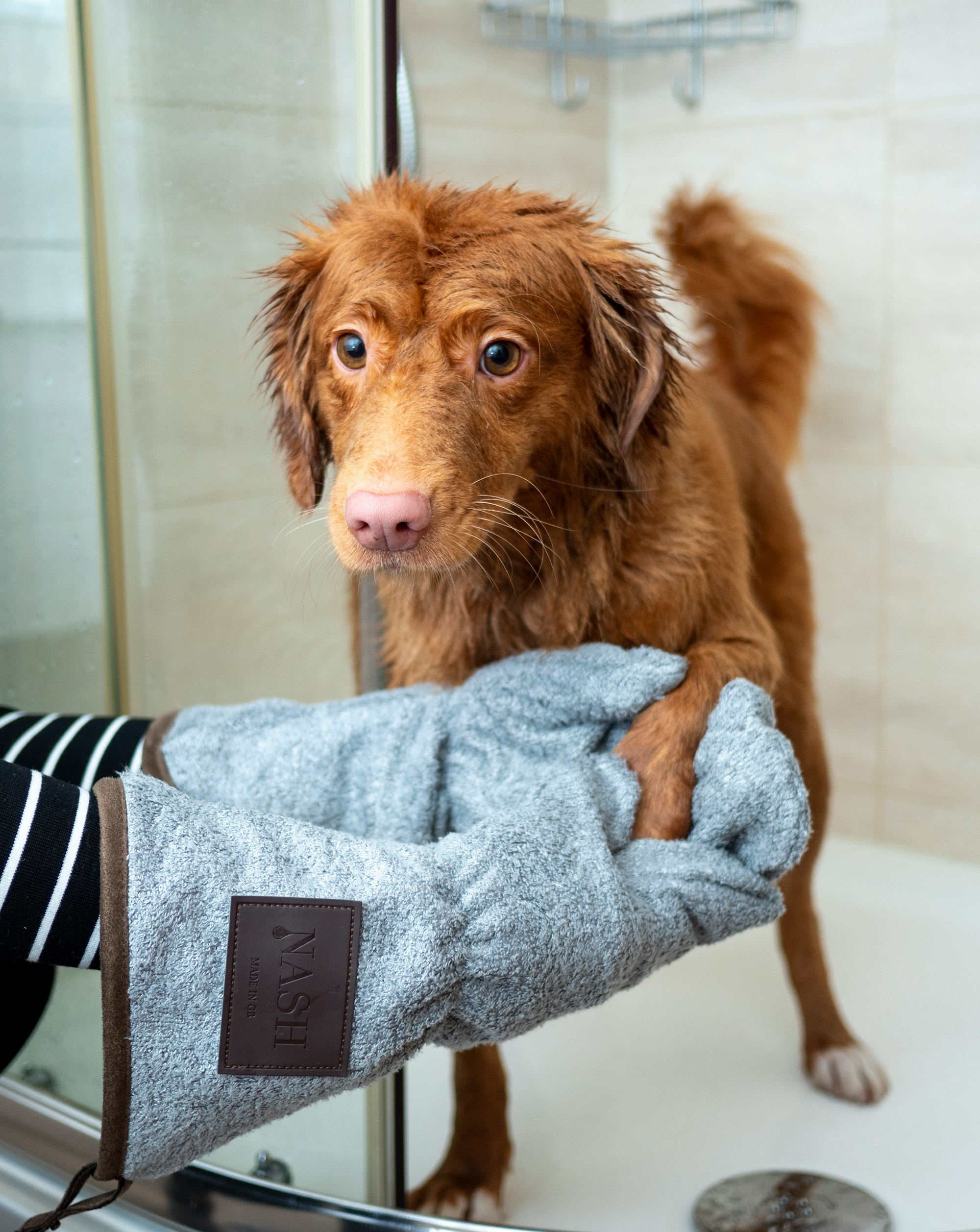You're lounging on your couch, scrolling through your phone when a peculiar noise interrupts the tranquility - a noise akin to gagging. You look over and it's your dog, he's dry heaving, but nothing seems to come out. You find yourself googling 'why is my dog dry heaving?'
We've all been there, haven't we? Worried, confused, and clueless about what's happening to our four-legged friends.
Unraveling the Mystery: What is Dry Heaving?
Dry heaving, also known as retching, can be scary. It's that awful sound your dog makes, akin to vomiting, but without any substance coming out. In reality, it's a natural protective mechanism, helping your dog eliminate something that's bothering their stomach. Sometimes it's benign, other times it could be a sign of a more serious issue.
Let's delve into the dog gagging causes and learn more about this peculiar behavior.

Why Does My Dog Dry Heave?
There are several reasons why your furry friend might be dry heaving.
Sometimes, it's due to their enthusiastic approach to a new squeaky toy, where they overexert themselves, causing momentary dry heaving. Other times, it could be a symptom of more significant dog health symptoms like gastrointestinal issues or respiratory problems.
In the case of a dog I once knew, "Max," dry heaving was a result of his adventurous spirit. Max loved hiking, he was never happier than when exploring the great outdoors. However, one fine day, Max began to dry heave after an especially long hiking trip. Max's owner was concerned and sought immediate veterinary assistance. After a few tests, it turned out to be a case of overexertion coupled with dehydration. It was a relief to know that it wasn't a serious health issue.
Uncommon Reasons for Dog Dry Heaving
You're now probably thinking, "My dog doesn't go hiking, so what could be the cause?"
Well, another cause could be allergies. You might be surprised, but just like us, dogs can also have allergic reactions, resulting in symptoms like dry heaving. Bella, a beautiful Golden Retriever I encountered, would start dry heaving every spring. After a vet's visit, it was revealed that Bella was allergic to certain types of pollen. Proper allergy medication during springtime alleviated her symptoms.
Another factor can be what is known as a microchip complication. When a dog is microchipped, it's a straightforward process, and complications are quite rare. But, there can be occasional cases where the dog's body may react to the microchip, causing discomfort and, in some cases, dry heaving.
Decoding Dog Communication
Dry heaving can also be a form of dog communication. Remember, dogs can't talk. Their only way to communicate discomfort or distress is through body language and symptoms like dry heaving. Understanding your dog's normal behavior and any sudden changes is crucial in identifying any potential issues.
When to See the Vet
So, when should you seek veterinary advice for dogs if they're dry heaving? Any persistent symptoms, including dry heaving, should be addressed with your vet, especially if accompanied by lethargy, loss of appetite, or other behavioral changes.
In some cases, it might be an emergency. For instance, a condition known as Gastric Dilatation-Volvulus (GDV), commonly known as "bloat" in dogs, can cause dry heaving and is life-threatening if not treated immediately.
In this journey of unraveling the mystery of why dogs dry heave, we've learned that it could be a simple reaction to overexertion, allergies, a reaction to a microchip, or a severe condition like GDV.
Remember, the key to a happy dog is regular check-ups and keen observation. These can ensure that your dog's health is monitored, and any unusual behavior can be addressed promptly. This mystery might be complex, but with a bit of understanding, it's definitely not unsolvable.

Fun Fact: The Dog Closest to a Wolf
While it's far from dry heaving, did you know that dogs share a common ancestor with wolves? Indeed, the dog breed closest to a wolf genetically is the Siberian Husky. It's fascinating how our domesticated fur buddies are related to their wild counterparts, isn't it?
So next time your dog is dry heaving, remember not to panic. Understand the potential causes, and when in doubt, always consult your vet. After all, a healthy dog is a happy dog.
Potential Treatments and Prevention Measures for Dog Dry Heaving
Now that we've uncovered the potential causes behind your dog's dry heaving, it's time to consider possible treatments and prevention strategies.
If your dog's dry heaving is due to overexertion, as was the case with our hiking enthusiast Max, the key is to ensure they have plenty of water during their vigorous playtime or exercise. Always keep an eye on their behavior, and if you notice signs of excessive panting or fatigue, it might be a good idea to take a breather.
On the other hand, if allergies are the culprit, your vet may prescribe certain medications to help alleviate the symptoms, like with Bella and her pollen issue. It's also vital to limit their exposure to the allergen as much as possible once it's been identified.
In the rare case of a microchip complication, you'd need to consult with your vet immediately. They may recommend monitoring your dog for a specific period, or in some cases, might suggest removing or repositioning the microchip.
What About Serious Conditions?
For more serious conditions like GDV, immediate veterinary intervention is critical. This condition often requires surgical intervention to correct. Regular vet check-ups and awareness of your dog's normal behavior are crucial to catch such serious conditions early.
The Importance of a Balanced Diet
One important yet often overlooked factor in preventing dog dry heaving is their diet. Ensuring your dog gets a balanced, high-quality diet can go a long way in maintaining their overall health. Consider including fiber-rich foods and probiotics in their diet, which can promote healthy digestion and potentially reduce incidents of dry heaving.
If you have a breed that's genetically more predisposed to GDV, such as the Great Dane or German Shepherds, consider feeding them smaller meals throughout the day instead of one large meal. This can help prevent the stomach from stretching and twisting.

Building a Strong Relationship with Your Dog
In the end, the key to identifying, addressing, and even preventing your dog's dry heaving is understanding their normal behavior. Just like humans, every dog has its unique way of expressing distress, whether it's through physical symptoms like dry heaving or changes in behavior. Paying attention to these signals can be crucial in ensuring your dog's health and happiness.
Also, remember that a dog's physical health is closely tied to their emotional well-being. A happy dog is more likely to be a healthy dog. So, make sure you're providing a loving, nurturing environment for your furry friend. After all, our dogs give us so much love and joy; it's only fair we do our part to ensure their happiness and health.
And that's the end of our journey into the mystery of dog dry heaving. It's not always a simple path, but with understanding, attention, and a little help from our vet, it's a mystery we can certainly unravel. Your dog is more than just a pet; they're a member of your family, and their health matters. So, the next time your dog starts dry heaving, you'll know exactly what steps to take.
Providing a Safe Environment
Ensuring that your dog's environment is safe is another important aspect to consider. This includes being cautious about the toys you provide and the objects they can access.
For instance, some dogs might chew and swallow pieces of toys, which can lead to gastrointestinal blockage and symptoms like dry heaving. Keep an eye on the state of your dog's toys and replace them when they become overly worn or damaged.
Likewise, ensure that potential allergens are minimized in their environment. This could be as simple as keeping your home dust-free or being mindful of plants and flowers if your dog has pollen allergies, as we discussed earlier with Bella, the Golden Retriever.
The Power of Observation
A key factor in keeping your dog healthy and preventing dry heaving is simply observation. Remember, dogs cannot tell us when they're feeling unwell. However, they communicate in many other ways - changes in behavior, appetite, or energy levels can all signal that something might be amiss.
The case of Max, the hiking dog, is a perfect example. His owner noticed his dry heaving after the hikes and immediately sought veterinary advice, effectively preventing a potentially serious condition.
Emotional Well-being is Key
Lastly, but certainly not least, your dog's emotional well-being plays a crucial role in their overall health. Anxiety or stress can sometimes cause dogs to exhibit physical symptoms like dry heaving. Make sure you're providing them with plenty of love, attention, and reassurance.
Engaging in activities that they enjoy, such as walks in the park, a game of fetch, or even a relaxing cuddle on the couch can significantly improve your dog's emotional health. After all, a happy dog is more likely to be a healthy dog.
In the end, we come full circle to the question, "Why is my dog dry heaving?" As we've learned, the answer can be multifaceted and might require a bit of detective work. But with the knowledge we've acquired, we're better prepared to address the issue and ensure our dogs lead a happy, healthy life.
Understanding our canine friends may seem complex at times, but the love and companionship they provide us are definitely worth the effort. So, keep observing, keep loving, and keep caring for your dog. After all, they're not just pets; they're part of our family.

Introducing Fi Dog Collars: A New Age Solution
As we've navigated through the maze of possible causes and treatments for dog dry heaving, let's introduce a handy tool that could assist you along the journey - the Fi dog collar.
The Fi dog collar is an innovative, smart device that helps monitor your dog's health, location, and activity levels. This high-tech collar fits into our discussion perfectly, offering a practical solution to many of the issues we've touched on.
Activity Tracking: Ensuring Your Dog Isn't Overexerting
Remember our adventurous friend Max? With the Fi collar, tracking the activity levels of a highly energetic dog like him is effortless. It can help you ensure they aren't overexerting, which could lead to dry heaving. The collar's activity tracker offers data on steps taken and overall active minutes, helping you better gauge whether your dog is getting the right amount of exercise.
Allergies and the Fi Collar
When it comes to allergies, the Fi dog collar might not directly diagnose the condition, but it can alert you to significant changes in your dog's behavior that could indicate discomfort. Increased scratching, decreased activity, or changes in sleep patterns could hint at an allergic reaction. Having this information handy when you visit the vet can contribute to a more accurate diagnosis.
The Fi Collar's Microchip Technology
As we discussed, complications from microchip implants, though rare, can potentially lead to dry heaving. Here, the Fi dog collar offers a unique advantage. It employs GPS technology to keep tabs on your furry friend, eliminating the need for a separate microchip. It's a win-win situation - you can track your dog's location without the potential health risks associated with microchips.
Enhancing Dog Communication
Since dry heaving can be a form of dog communication, the insights provided by the Fi collar can be a game-changer. By monitoring your dog's activity and sleep, the collar offers crucial data on any changes in your dog's normal behavior, allowing you to respond promptly.
Fi Dog Collar: Your Partner in Ensuring a Happy Dog
In conclusion, the Fi dog collar can be a valuable ally in maintaining your dog's health and preventing issues like dry heaving. This advanced piece of technology allows you to monitor your dog's activity levels, helping you understand their behavior better and detect any potential health issues.
Coupled with regular vet check-ups, a safe environment, and plenty of love and attention, the Fi dog collar can aid you significantly in the journey of keeping your dog not just healthy, but happy too.
Isn't it exciting to see how modern technology can assist us in better understanding and caring for our beloved pets? The Fi collar is indeed a splendid example of this - a perfect blend of technology and pet care, for the ultimate well-being of our furry family members.
Conclusion:
In conclusion, unravelling the mystery of why your dog is dry heaving involves understanding its causes, which range from harmless instances like overexcitement to serious conditions like GDV. Regular vet check-ups, balanced diets, and safe environments play pivotal roles in maintaining your dog's health.
Observing changes in your dog's behavior can alert you to potential issues, and ensuring their emotional well-being is just as vital. An innovative tool like the Fi dog collar can provide insights into your dog's activities, aiding early detection of health issues, and eliminating the need for separate microchip implants.
Ultimately, the health and happiness of our furry friends hinge on our ability to observe, understand, and respond to their needs promptly and appropriately. With knowledge and attention, we can ensure that our dogs lead a happy and healthy life.




